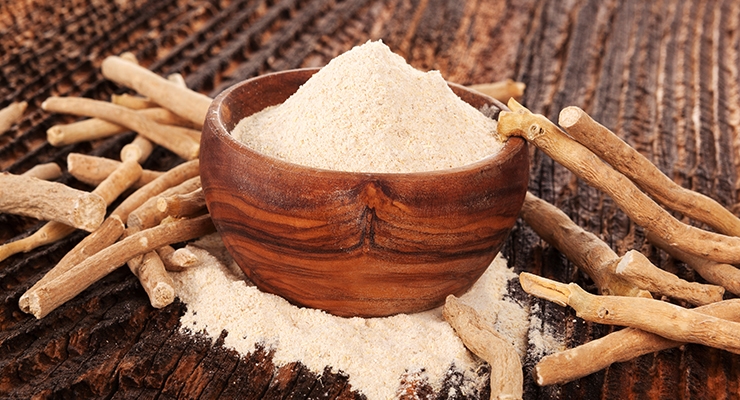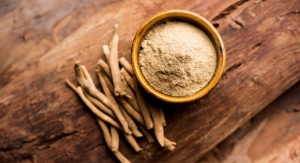By Sean Moloughney, Editor05.31.18
One of the most well-known botanical plants in traditional Ayurvedic medicine, ashwagandha (Withania somnifera) has gained attention in the health and wellness industry for its restorative and rejuvenating benefits. Offering a variety of applications, including as a general tonic, the root can be used as an adaptogen, meaning it helps the body cope with stress.
Ashwagandha is frequently referred to as “Indian ginseng” because of its rejuvenating properties, even though botanically, ginseng and ashwagandha are unrelated. Belonging to the same nightshade family as tomato, eggplant, and potato, ashwagandha is a shrub with oval leaves and yellow flowers. It bears red fruit about the size of a raisin. The herb is native to arid regions of India, northern Africa, and the Middle East, and is also grown today in more moderate climates.
The name “ashwagandha” is derived from two Sanskrit words: “ashwa” meaning “horse” and “gandha” meaning “smell,” which roughly translates to “horse-like smell,” or “horse essence,” which could be a reference to the traditional belief that the root provides the strength, character, essence, or stamina of a stallion.
“In addition, the species name somnifera refers to the Latin ‘somnus’ meaning ‘to sleep,’ which perhaps signifies the traditional use of ashwagandha as a nervine and sedative,” noted Shaheen Majeed, president—worldwide, Sabinsa. “In Ayurveda, ashwagandha is classified under rasayanas, meaning ‘rejuvenative tonics.’ Hence, in India, traditionally, it was widely used as a tonic in people of all ages for a range of imbalances.”
Traditional Use & Modern Application
Ashwagandha has been used in the “ancient but modern ways of Ayurveda for more than 5,000 years,” said Shailinder Sodhi, ND, BAMS, president of Ayush Herbs and associate professor Bastyr University. “Its adaptogenic effects have been celebrated in males and females, children and adults. The roots of this plant can be used alone or synergistically with other herbs to treat the nervous, immune, musculoskeletal systems, as well as increasing health in the reproductive organs and endocrine systems. Recently, research on the oncological uses have been published, as well as for immunological functions.”
As an adaptogen, ashwagandha is capable of responding to stress in anyway the body needs, he added. “This means it can down-regulate or up-regulate cellular processes. Ashwagandha balances stress hormones such as cortisol, is used as a neurological treatment, helps with the treatment of mental illness, is an aphrodisiac, and can tone the muscles. Furthermore, ashwagandha can heal both reproductive systems, assisting in healthy pregnancy and conception.”
Kartikeya Baldwa, director and CEO, Ixoreal Biomed Inc., maker of KSM-66 Ashwagandha, noted that Ayurveda textbooks list about 30 applications for this potent herb, ranging from “strength and stamina to immunity and recuperation; from stress relief and mental resilience to memory and cognition; and from hemoglobin count and thyroid function to hair melanin pigmentation and joint tissue.”
Ashwagandha is also known as the “Prince of Herbs” because of its broad range of traditional uses, according to Mr. Majeed. “It is believed to promote youthfulness and longevity and alleviate suffering. Other documented uses of ashwagandha include healthy inflammatory and immune support, as a mild purgative, in the management of glandular swelling, to improve vigor in men, to increase production of breast milk, cognitive support, and to improve muscular energy, alleviate stress, and to manage ulcers.”
Mr. Baldwa added that a wide range of effects have been documented in pharmacological literature. “It has been characterized as adaptogenic, anxiolytic, cognitive enhancing, sexual function enhancing, cardioprotective, thyroid modulati`ng,” among others, he said.
The adaptogenic benefits of ashwagandha should be considered as an umbrella that encompasses the other benefits. “Adaptogens are a special class of herbs that help the body regulate natural metabolism and create balance in the body. They also help raise an individual’s resistance to physical, chemical, and biological stressors. Adaptogenic herbs tend to grow in harsh climatic conditions; for example, ashwagandha grows in the desert, and maca in the heights of the Andes Mountains. It is believed that adaptogenic herbs contain bioactives that help these plants withstand external stressors and similarly help humans who ingest these herbs.”
Modern research has further explored ashwagandha’s health benefits. For example, in human clinical trial testing, researchers have demonstrated that Sensoril ashwagandha, a multi-patented, self-affirmed GRAS extract of ashwagandha root and leaf from Innophos, helps reduce stress while enhancing mood, promotes better concentration and memory, provides more restful sleep, supports metabolic wellness (including cardiovascular health and blood sugar balance), promotes healthy joint function, and provides healthy energy while reducing fatigue, according to the company. Sensoril ashwagandha is standardized to ≥10% glycowithanolides. In 2017 Innophos acquired NutraGenesis, the exclusive North American provider of Sensoril ashwagandha.
Sensoril ashwagandha has been evaluated in multiple randomized, double-blind, placebo-controlled human clinical trials. For example, in a 60-day trial involving 98 subjects with moderate levels of stress, participants took 125 mg of Sensoril ashwagandha once or twice daily (or matching placebo). Consumption of Sensoril ashwagandha resulted in significant reductions in the stress hormone cortisol, as well as improvements in cardiovascular health measures, blood sugar balance, and perceived level of stress and anxiety, fatigue, concentration, memory, and sleep (JANA, 2008).
Also, in a 12-week study, 60 subjects with knee discomfort took twice daily either Sensoril ashwagandha at a dose of 125 mg or 250 mg, or matching placebo. Both Sensoril ashwagandha doses resulted in significant improvements in joint health based on a modified WOMAC (Western Ontario and McMaster Universities Arthritis Index) at week 8 and week 12, as well as improvements in joint circumference and a physician’s global assessment at week 12. The 250 mg twice daily dose also showed significant improvements in all assessed variables at week 4 and week 8 (Pharmacogn Res, 2014).
Further, researchers evaluated Sensoril ashwagandha’s ability to help support healthy cognitive function using validated cognitive tests in a 6-week crossover trial with 20 subjects. Subjects took either 500 mg twice daily of Sensoril ashwagandha or matching placebo. Consumption of Sensoril ashwagandha led to significant improvements in Reaction Time, Digital System Substitution, Digit Vigilance Task, and Card Sorting, which evaluate working memory, reaction time, and the ability to process and store information (J Ayurveda Integr Med, 2016).
Mr. Baldwa said KSM-66 Ashwagandha is supported by an extensive body of clinical evidence: 10 published studies, six additional studies completed and in peer review, and eight ongoing studies. “KSM-66 Ashwagandha has been clinically proven to help 1) reduce stress, anxiety, cortisol levels and stress-related food cravings, 2) promote enhanced memory and cognitive function, 3) promote endurance, strength, muscle size and muscle recovery rate, and 4) enhance sexual performance health in both men and women, and testosterone in men. All of KSM-66 clinical studies follow the gold standards of substantiation: randomized, double-blind, placebo-controlled designs.”
Growth Trends
Sales of Ayurvedic herbs such as turmeric and ashwagandha have posted significant growth over the last few years, as consumers recognize that traditional Ayurvedic medicine offers effective alternatives to Western medicine, with fewer adverse effects. In fact, Innova Market Insights reported +18% average annual growth for global new product launches featuring ashwagandha as an ingredient (CAGR 2013-2017). In 2017, 49% of all new product launches reported with ashwagandha as an ingredient featured an energy claim.
Consumers are becoming aware of ashwagandha’s wide-ranging health benefits, as more companies support their products/formulations with clinical substantiatiation, said Mr. Majeed. “The rise in demand for ashwagandha can be attributed to its proven benefits in sports nutrition, improved quality of life, and improved muscle growth and recovery.”
Dr. Sodhi noted that Ayush Herbs works to educate healthcare professional to pass information on to consumers. Overall, people are looking for natural products to reduce side effects of pharmaceuticals, he said.
Mr. Baldwa agreed that more consumers are looking for natural products, noting several other trends driving awareness and usage of ashwagandha. “Consumers are monitoring what they eat much more carefully. They are looking not only at what kind of ingredients are in their products, they are also looking at what is not there—for instance, pesticides and GMOs. This is perhaps a consequence of more health education in schools and also more media coverage. Consumers are increasingly showing a preference for foods that are closer to nature, more transparent, less artificial, less chemically processed. Ashwagandha extracts like KSM-66 are true to traditional Ayurvedic practice.”
Consumers are also looking for specific benefits when they buy nutritional supplements, rather than general health products. “Indeed, for several years now, the growth in condition-specific supplements has been considerably greater than in general supplements. In particular, consumers are increasingly looking for functional benefits like stress relief, brain health, endurance, strength, recovery, and sexual function. Ashwagandha has been traditionally used for many of these functions.”
However, the mere notion that ashwagandha has been used traditionally for many ailments isn’t enough to convince modern consumers, he added. “Consumers are increasingly demanding evidence and validation in support of these functional claims. We see more consumers of all ages scrutinizing package labels and investigating ingredients. To appeal to these consumers, firms need to present scientific data and evidence in a manner that is easy to understand and not too complicated.”
Quality Matters
Though ashwagandha has been used since ancient times, quality does vary, so safety and quality should be the top priority for formulators and marketers, according to Mr. Majeed. “While sourcing popular and distinctive ingredients like ashwagandha, one has to be vigilant about the authenticity of the raw material and its source. Similarly, a battery of standard and fit for purpose quality tests should be conducted for each and every batch of raw material to rule out quality-related issues. Furthermore, formulators should collaborate with industry-trusted suppliers like Sabinsa to ensure a constant supply of high-quality materials, because we truly understand the importance of supply chain integrity.”
Companies should pay attention to the time of year ashwagandha is harvested, said Dr. Sodhi, as well as the treatment of farmers. “Furthermore, ensure the extraction process does not use toxic solvents. Ensure that the product is tested in house and using a third party for constituent presence, purity, and identification of the herb, and finally a microbial profile.”
Ultimately, companies should partner with suppliers that make quality and transparency a key focus of their business.
Ashwagandha is frequently referred to as “Indian ginseng” because of its rejuvenating properties, even though botanically, ginseng and ashwagandha are unrelated. Belonging to the same nightshade family as tomato, eggplant, and potato, ashwagandha is a shrub with oval leaves and yellow flowers. It bears red fruit about the size of a raisin. The herb is native to arid regions of India, northern Africa, and the Middle East, and is also grown today in more moderate climates.
The name “ashwagandha” is derived from two Sanskrit words: “ashwa” meaning “horse” and “gandha” meaning “smell,” which roughly translates to “horse-like smell,” or “horse essence,” which could be a reference to the traditional belief that the root provides the strength, character, essence, or stamina of a stallion.
“In addition, the species name somnifera refers to the Latin ‘somnus’ meaning ‘to sleep,’ which perhaps signifies the traditional use of ashwagandha as a nervine and sedative,” noted Shaheen Majeed, president—worldwide, Sabinsa. “In Ayurveda, ashwagandha is classified under rasayanas, meaning ‘rejuvenative tonics.’ Hence, in India, traditionally, it was widely used as a tonic in people of all ages for a range of imbalances.”
Traditional Use & Modern Application
Ashwagandha has been used in the “ancient but modern ways of Ayurveda for more than 5,000 years,” said Shailinder Sodhi, ND, BAMS, president of Ayush Herbs and associate professor Bastyr University. “Its adaptogenic effects have been celebrated in males and females, children and adults. The roots of this plant can be used alone or synergistically with other herbs to treat the nervous, immune, musculoskeletal systems, as well as increasing health in the reproductive organs and endocrine systems. Recently, research on the oncological uses have been published, as well as for immunological functions.”
As an adaptogen, ashwagandha is capable of responding to stress in anyway the body needs, he added. “This means it can down-regulate or up-regulate cellular processes. Ashwagandha balances stress hormones such as cortisol, is used as a neurological treatment, helps with the treatment of mental illness, is an aphrodisiac, and can tone the muscles. Furthermore, ashwagandha can heal both reproductive systems, assisting in healthy pregnancy and conception.”
Kartikeya Baldwa, director and CEO, Ixoreal Biomed Inc., maker of KSM-66 Ashwagandha, noted that Ayurveda textbooks list about 30 applications for this potent herb, ranging from “strength and stamina to immunity and recuperation; from stress relief and mental resilience to memory and cognition; and from hemoglobin count and thyroid function to hair melanin pigmentation and joint tissue.”
Ashwagandha is also known as the “Prince of Herbs” because of its broad range of traditional uses, according to Mr. Majeed. “It is believed to promote youthfulness and longevity and alleviate suffering. Other documented uses of ashwagandha include healthy inflammatory and immune support, as a mild purgative, in the management of glandular swelling, to improve vigor in men, to increase production of breast milk, cognitive support, and to improve muscular energy, alleviate stress, and to manage ulcers.”
Mr. Baldwa added that a wide range of effects have been documented in pharmacological literature. “It has been characterized as adaptogenic, anxiolytic, cognitive enhancing, sexual function enhancing, cardioprotective, thyroid modulati`ng,” among others, he said.
The adaptogenic benefits of ashwagandha should be considered as an umbrella that encompasses the other benefits. “Adaptogens are a special class of herbs that help the body regulate natural metabolism and create balance in the body. They also help raise an individual’s resistance to physical, chemical, and biological stressors. Adaptogenic herbs tend to grow in harsh climatic conditions; for example, ashwagandha grows in the desert, and maca in the heights of the Andes Mountains. It is believed that adaptogenic herbs contain bioactives that help these plants withstand external stressors and similarly help humans who ingest these herbs.”
Modern research has further explored ashwagandha’s health benefits. For example, in human clinical trial testing, researchers have demonstrated that Sensoril ashwagandha, a multi-patented, self-affirmed GRAS extract of ashwagandha root and leaf from Innophos, helps reduce stress while enhancing mood, promotes better concentration and memory, provides more restful sleep, supports metabolic wellness (including cardiovascular health and blood sugar balance), promotes healthy joint function, and provides healthy energy while reducing fatigue, according to the company. Sensoril ashwagandha is standardized to ≥10% glycowithanolides. In 2017 Innophos acquired NutraGenesis, the exclusive North American provider of Sensoril ashwagandha.
Sensoril ashwagandha has been evaluated in multiple randomized, double-blind, placebo-controlled human clinical trials. For example, in a 60-day trial involving 98 subjects with moderate levels of stress, participants took 125 mg of Sensoril ashwagandha once or twice daily (or matching placebo). Consumption of Sensoril ashwagandha resulted in significant reductions in the stress hormone cortisol, as well as improvements in cardiovascular health measures, blood sugar balance, and perceived level of stress and anxiety, fatigue, concentration, memory, and sleep (JANA, 2008).
Also, in a 12-week study, 60 subjects with knee discomfort took twice daily either Sensoril ashwagandha at a dose of 125 mg or 250 mg, or matching placebo. Both Sensoril ashwagandha doses resulted in significant improvements in joint health based on a modified WOMAC (Western Ontario and McMaster Universities Arthritis Index) at week 8 and week 12, as well as improvements in joint circumference and a physician’s global assessment at week 12. The 250 mg twice daily dose also showed significant improvements in all assessed variables at week 4 and week 8 (Pharmacogn Res, 2014).
Further, researchers evaluated Sensoril ashwagandha’s ability to help support healthy cognitive function using validated cognitive tests in a 6-week crossover trial with 20 subjects. Subjects took either 500 mg twice daily of Sensoril ashwagandha or matching placebo. Consumption of Sensoril ashwagandha led to significant improvements in Reaction Time, Digital System Substitution, Digit Vigilance Task, and Card Sorting, which evaluate working memory, reaction time, and the ability to process and store information (J Ayurveda Integr Med, 2016).
Mr. Baldwa said KSM-66 Ashwagandha is supported by an extensive body of clinical evidence: 10 published studies, six additional studies completed and in peer review, and eight ongoing studies. “KSM-66 Ashwagandha has been clinically proven to help 1) reduce stress, anxiety, cortisol levels and stress-related food cravings, 2) promote enhanced memory and cognitive function, 3) promote endurance, strength, muscle size and muscle recovery rate, and 4) enhance sexual performance health in both men and women, and testosterone in men. All of KSM-66 clinical studies follow the gold standards of substantiation: randomized, double-blind, placebo-controlled designs.”
Growth Trends
Sales of Ayurvedic herbs such as turmeric and ashwagandha have posted significant growth over the last few years, as consumers recognize that traditional Ayurvedic medicine offers effective alternatives to Western medicine, with fewer adverse effects. In fact, Innova Market Insights reported +18% average annual growth for global new product launches featuring ashwagandha as an ingredient (CAGR 2013-2017). In 2017, 49% of all new product launches reported with ashwagandha as an ingredient featured an energy claim.
Consumers are becoming aware of ashwagandha’s wide-ranging health benefits, as more companies support their products/formulations with clinical substantiatiation, said Mr. Majeed. “The rise in demand for ashwagandha can be attributed to its proven benefits in sports nutrition, improved quality of life, and improved muscle growth and recovery.”
Dr. Sodhi noted that Ayush Herbs works to educate healthcare professional to pass information on to consumers. Overall, people are looking for natural products to reduce side effects of pharmaceuticals, he said.
Mr. Baldwa agreed that more consumers are looking for natural products, noting several other trends driving awareness and usage of ashwagandha. “Consumers are monitoring what they eat much more carefully. They are looking not only at what kind of ingredients are in their products, they are also looking at what is not there—for instance, pesticides and GMOs. This is perhaps a consequence of more health education in schools and also more media coverage. Consumers are increasingly showing a preference for foods that are closer to nature, more transparent, less artificial, less chemically processed. Ashwagandha extracts like KSM-66 are true to traditional Ayurvedic practice.”
Consumers are also looking for specific benefits when they buy nutritional supplements, rather than general health products. “Indeed, for several years now, the growth in condition-specific supplements has been considerably greater than in general supplements. In particular, consumers are increasingly looking for functional benefits like stress relief, brain health, endurance, strength, recovery, and sexual function. Ashwagandha has been traditionally used for many of these functions.”
However, the mere notion that ashwagandha has been used traditionally for many ailments isn’t enough to convince modern consumers, he added. “Consumers are increasingly demanding evidence and validation in support of these functional claims. We see more consumers of all ages scrutinizing package labels and investigating ingredients. To appeal to these consumers, firms need to present scientific data and evidence in a manner that is easy to understand and not too complicated.”
Quality Matters
Though ashwagandha has been used since ancient times, quality does vary, so safety and quality should be the top priority for formulators and marketers, according to Mr. Majeed. “While sourcing popular and distinctive ingredients like ashwagandha, one has to be vigilant about the authenticity of the raw material and its source. Similarly, a battery of standard and fit for purpose quality tests should be conducted for each and every batch of raw material to rule out quality-related issues. Furthermore, formulators should collaborate with industry-trusted suppliers like Sabinsa to ensure a constant supply of high-quality materials, because we truly understand the importance of supply chain integrity.”
Companies should pay attention to the time of year ashwagandha is harvested, said Dr. Sodhi, as well as the treatment of farmers. “Furthermore, ensure the extraction process does not use toxic solvents. Ensure that the product is tested in house and using a third party for constituent presence, purity, and identification of the herb, and finally a microbial profile.”
Ultimately, companies should partner with suppliers that make quality and transparency a key focus of their business.




























